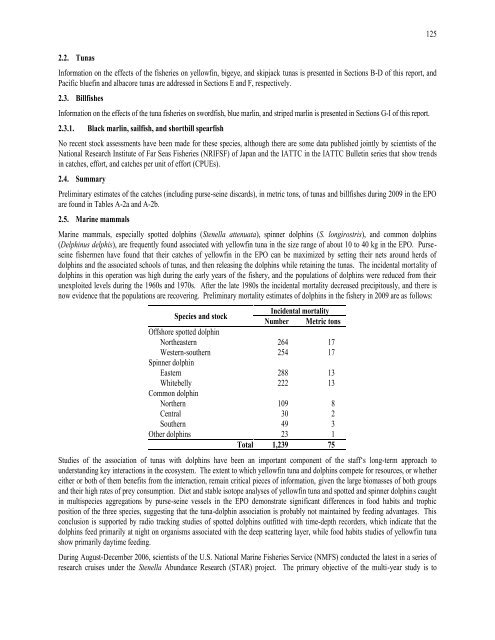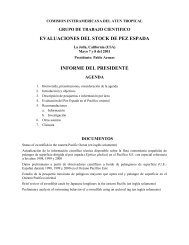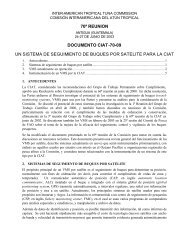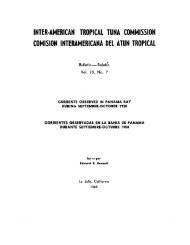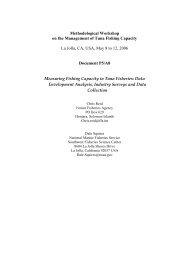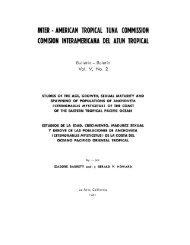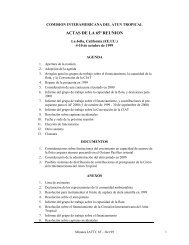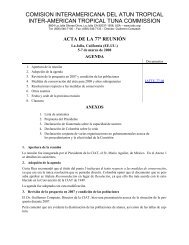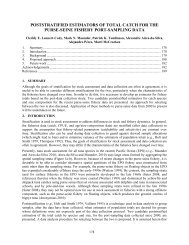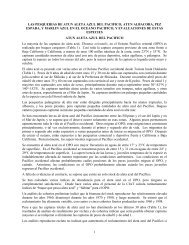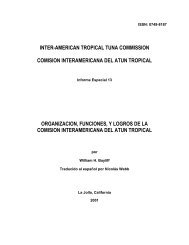IATTC Fishery Status Report 8 - Comisión Interamericana del Atún ...
IATTC Fishery Status Report 8 - Comisión Interamericana del Atún ...
IATTC Fishery Status Report 8 - Comisión Interamericana del Atún ...
Create successful ePaper yourself
Turn your PDF publications into a flip-book with our unique Google optimized e-Paper software.
2.2. Tunas<br />
Information on the effects of the fisheries on yellowfin, bigeye, and skipjack tunas is presented in Sections B-D of this report, and<br />
Pacific bluefin and albacore tunas are addressed in Sections E and F, respectively.<br />
2.3. Billfishes<br />
Information on the effects of the tuna fisheries on swordfish, blue marlin, and striped marlin is presented in Sections G-I of this report.<br />
2.3.1. Black marlin, sailfish, and shortbill spearfish<br />
No recent stock assessments have been made for these species, although there are some data published jointly by scientists of the<br />
National Research Institute of Far Seas Fisheries (NRIFSF) of Japan and the <strong>IATTC</strong> in the <strong>IATTC</strong> Bulletin series that show trends<br />
in catches, effort, and catches per unit of effort (CPUEs).<br />
2.4. Summary<br />
Preliminary estimates of the catches (including purse-seine discards), in metric tons, of tunas and billfishes during 2009 in the EPO<br />
are found in Tables A-2a and A-2b.<br />
2.5. Marine mammals<br />
Marine mammals, especially spotted dolphins (Stenella attenuata), spinner dolphins (S. longirostris), and common dolphins<br />
(Delphinus <strong>del</strong>phis), are frequently found associated with yellowfin tuna in the size range of about 10 to 40 kg in the EPO. Purseseine<br />
fishermen have found that their catches of yellowfin in the EPO can be maximized by setting their nets around herds of<br />
dolphins and the associated schools of tunas, and then releasing the dolphins while retaining the tunas. The incidental mortality of<br />
dolphins in this operation was high during the early years of the fishery, and the populations of dolphins were reduced from their<br />
unexploited levels during the 1960s and 1970s. After the late 1980s the incidental mortality decreased precipitously, and there is<br />
now evidence that the populations are recovering. Preliminary mortality estimates of dolphins in the fishery in 2009 are as follows:<br />
Species and stock<br />
Incidental mortality<br />
Number Metric tons<br />
Offshore spotted dolphin<br />
Northeastern 264 17<br />
Western-southern 254 17<br />
Spinner dolphin<br />
Eastern 288 13<br />
Whitebelly 222 13<br />
Common dolphin<br />
Northern 109 8<br />
Central 30 2<br />
Southern 49 3<br />
Other dolphins 23 1<br />
Total 1,239 75<br />
Studies of the association of tunas with dolphins have been an important component of the staff‘s long-term approach to<br />
understanding key interactions in the ecosystem. The extent to which yellowfin tuna and dolphins compete for resources, or whether<br />
either or both of them benefits from the interaction, remain critical pieces of information, given the large biomasses of both groups<br />
and their high rates of prey consumption. Diet and stable isotope analyses of yellowfin tuna and spotted and spinner dolphins caught<br />
in multispecies aggregations by purse-seine vessels in the EPO demonstrate significant differences in food habits and trophic<br />
position of the three species, suggesting that the tuna-dolphin association is probably not maintained by feeding advantages. This<br />
conclusion is supported by radio tracking studies of spotted dolphins outfitted with time-depth recorders, which indicate that the<br />
dolphins feed primarily at night on organisms associated with the deep scattering layer, while food habits studies of yellowfin tuna<br />
show primarily daytime feeding.<br />
During August-December 2006, scientists of the U.S. National Marine Fisheries Service (NMFS) conducted the latest in a series of<br />
research cruises under the Stenella Abundance Research (STAR) project. The primary objective of the multi-year study is to<br />
125


